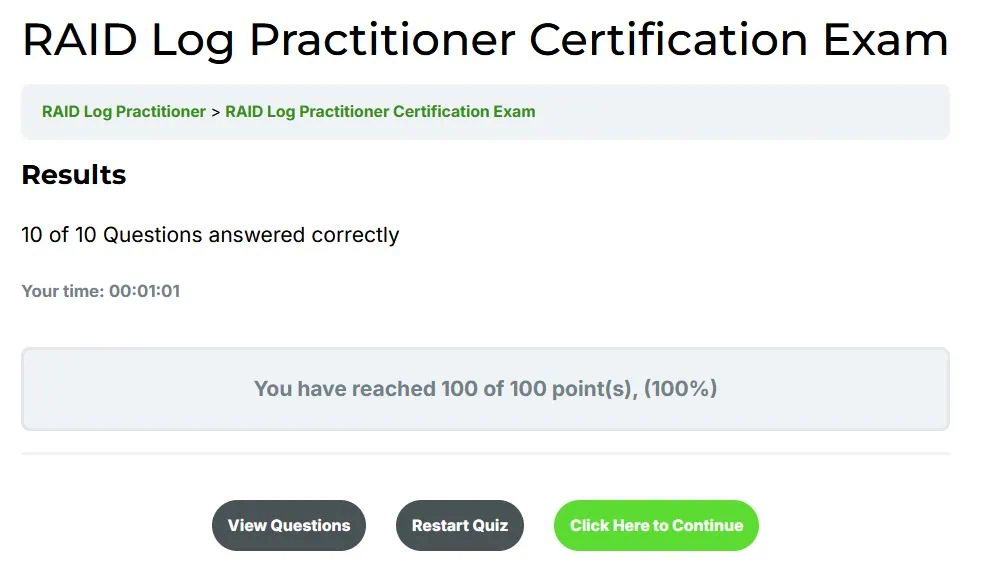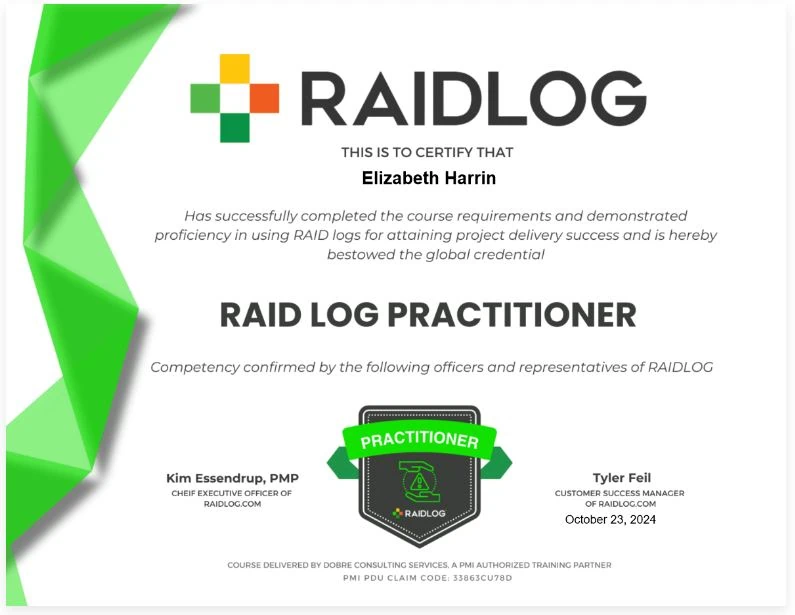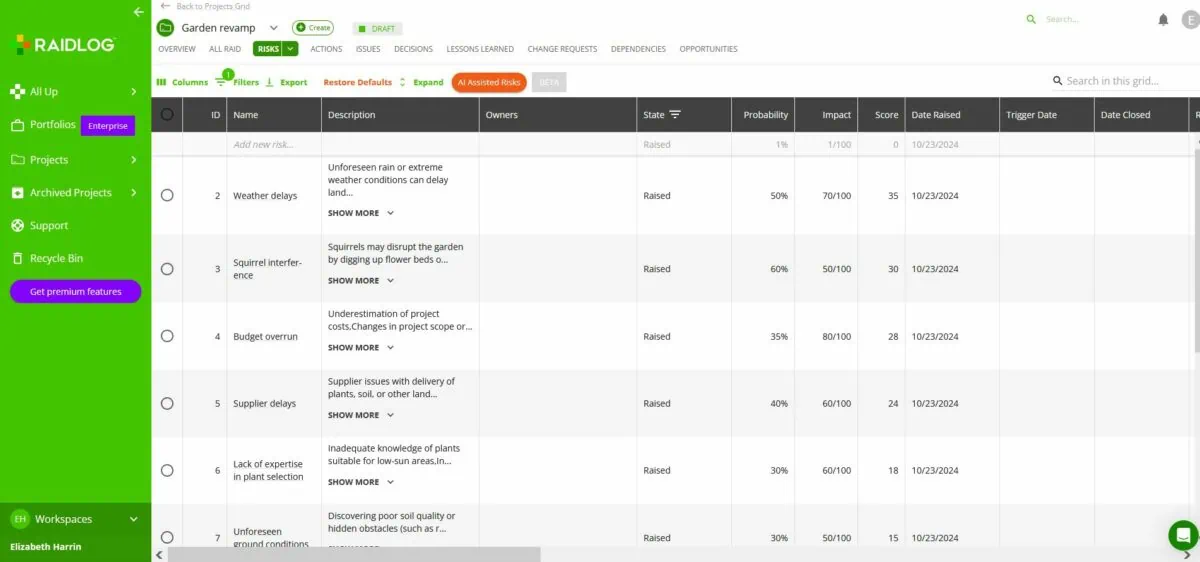RAID Log Practitioner Course Review
As a project manager, we’re constantly tracking actions, risks, issues, and more – these are the bread-and-butter activities for project managers to keep the project on track. But have you ever learned how to use a RAID log properly?
I hadn’t. It was something touched on in various training courses I’d done over the year, but I’d never had training on the ‘how’ of RAID logs. Until now. I took the RAID Log Practitioner training and it was surprisingly worth it!
In this RAID Log Practitioner course review, I’ll share:
- Why it’s worth doing a course specifically about RAID logs
- Why it’s especially good for early career project managers
- How to get the certificate.
I’ve used RAID logs in my project management practice for over 20 years, and I learned things on this course – the stack rank constraint priorities exercise was a real eye-opener and something I can definitely use with my stakeholders.

How I did this review
I joined a live, instructor-led online training course in October 2024 and took the certification test.
What is a RAID log?
I have a super-detailed article on what is a RAID log (the short answer is that RAID is an acronym of Risks, Actions/Assumptions, Issues, Decisions/Dependencies, and it’s a tool that project managers use to keep on top of their project work).
RAIDLOG is the company that runs the Practitioner course.
Why do a course on RAID?
I know, I had the same thought: is it really worth spending 4 hours learning what to put into a spreadsheet? What really do you have to learn about that? Especially as there are lots of good articles and videos about it online already.
However, I was surprised at how deep the course went. We dove deep into risk management and other areas, as well as the value of historical logging – and how this can save you!
I was skeptical about whether it was worth doing a whole course on this. But it turned out to be a good use of my time, more than just a refresher. So many nuggets of information!

Who is the RAID Log Practitioner course for?
As a result of doing the course, I can say that it’s aimed at project managers who want to, or who do, use RAID logs for the daily work management. It will help to have some knowledge of what they are and how you want to use them, but the training started with the basics so you don’t need any prior knowledge.
I thought the course was good for people who have had ‘general’ project management training, but who haven’t had any ‘how do I actually do this’ training.
This course is great for:
- People who want to work as a project/PMO analyst who would have responsibility for updating logs in their day job.
- Early career project managers who want the confidence that they are focusing on the right things that will keep the project moving forward.
- Project managers who want to ensure they are tracking work and staying as organized as they can.
- Project managers who need to get PDUs and want to do an interesting course! This training will offer you 4 PDUs and a certification.
66% of people surveyed (data shared in the training) said that RAID logs help keep them organized, and I certainly feel that is the case for me.
Other benefits shared in the training were communicating with stakeholders (51%), keeping the project Green and being a useful vehicle for covering your backside and keeping a record of what has happened.
About the course and structure
The training is made up of 4 parts. These are:
- Introduction to RAID logs
- RAID fundamentals
- Using your RAID log
- Beyond RAID
Intro to RAID logs
This was a very short overview section, followed by a quick break. It looked at what RAID is, why we should use it, the history of this tool and the trainer shared experiences of what happened in a project that didn’t have a log.
RAID fundamentals
The bulk of the training time, I’d say about 50%, was spent on reviewing the different types of items stored in a RAID log.
This part of the training looked at risk management, issue management, decision making and tracking, change requests, dependencies, lessons learned, action tracking and some of the other things you can include in log tabs.
We went into a lot of detail such as probability and impact scales, different types of lessons, action planning to manage items, trust bricks and a lot more.

Using your RAID log
This section covered how to use the list for communication and management, sharing it with stakeholders. We learned about using the log instead of meeting minutes and how to consolidate risks etc at portfolio level, how to use it for project recovery.
Beyond RAID
This was the section I was most looking forward to as it covered the use of AI, integrations and the future of the RAIDLOG software. It was the shortest part of the training overall.
Meet your trainer
My trainer was Kim Essendrup,
His style was easy, the slides were good, he got the audience to interact with the material. Kim clearly knows his stufff and included examples, quotes, stories etc to make it an engaging course.
How long does the RAID log training take?
It’s a live training course that takes 4 hours. There are (very short) breaks.
How the assessment works
There is a graded quiz at the end of the training. There are 10 questions. I didn’t find it very hard and there is the opportunity to retake if you need it.

What certificate do you get?
You get a downloadable PDF certificate, and a shareable LinkedIn badge. The certificate is ‘published’ in that you can share a link so that others can verify your achievement. You can see mine here.

You can submit your PDUs whether you pass the test or not. If you do pass, the system will automatically submit the PDUs for you – just make sure your PMI ID is on the record.
Pros
The benefits of doing this training are:
- It’s a great way to get into detail of a practical tool that will really help keep your project on track and moving forward in the right way.
- You are encouraged to create risks, issues etc during the training so you can get practical experience of how best to phrase and document items.
- It’s a live training, so you can ask questions.
The training is not tool-specific, so while you could use RAIDLOG to start tracking your activities (and you get 6 months professional license included in the cost of the training), you could simply use a spreadsheet or whatever your PMO mandates for project management software.
Cons
The disadvantages that I found are as follows.
- Four hours on Zoom is a long time. We did have breaks, but it made me realize that I have to struggle to stay engaged.
- Sometimes using the software to discuss the feature felt a bit long, like entering trigger dates and showing how to sort by those.
- I am jealous that I don’t have the software – heat maps and the sliders are really good, and you just can’t get that easily in Excel.
Finally, it’s worth mentioning that the company delivering the training also sells a project management software tool designed to manage your RAID log. The training was NOT a subtle pitch for the tool, but they did use the tool for exercises during the training. If you think your delegates would be very sensitive to anything that might feel like ‘sales’ then you might want to let them know that is how the course is going to be.

Recommendation: Should you buy this course?
If you are worried about work running away from you, then it’s worth investing in this training because it will help you in a very practical way.
It covers topics like risk appetite, risk tolerance and risk thresholds, plus deep dives into decision making, issue management processes and more. These might be new for you, and even if you think they are going to be a recap it’s worth it.
I learned things on this training, despite having done the job for many years. It’s only going to take you an afternoon and you’ll come away feeling like you have a renewed interest in making your RAID log work for you.
I was given the opportunity to take the RAID Log Practitioner Certification course in October 2024 by the training company – thank you!
